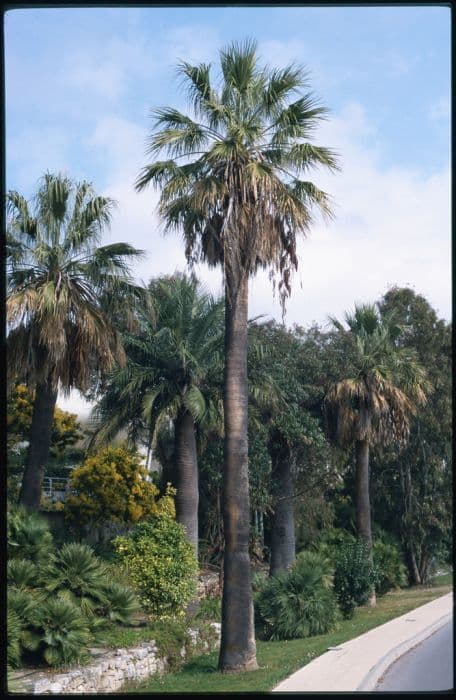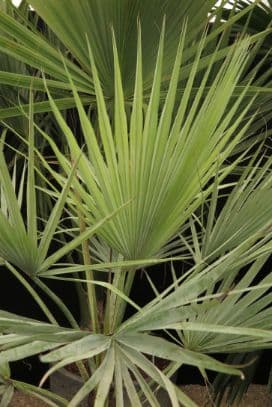Kentia palm Howea forsteriana



ABOUT
Howea is a single-stemmed palm that forms a number of stems with large, pinnately dissected leaf plates on top. To achieve lushness, several plants are planted in one pot.
Indoors, the palm reaches 50 inches in height. Outdoors can reach up to 33 feet in height and 20 feet wide.
Cultivated indoors when young, the Howea forms a large number of root shoots. As it matures, however, it forms a single, powerful trunk.
The indoor palm blooms very rarely. Flowering stems in the form of cobs with small white flowers are of no ornamental value.
The growth rate of the Howea is low - only a few leaves grow a year.
About this plant
 Names
NamesFamily
Arecaceae
Synonyms
Forster sentry palm, Kentia palm, Paradise palm, Sentry palm, Thatch palm, Flat palm, Thatch-leaf palm
Common names
Denea forsteriana, Grisebachia forsteriana, Kentia forsteriana
 Toxicity
ToxicityTo humans
Non-toxic, but avoid ingesting them and keep them away from pets. May cause personal intolerance if ingested.
To pets
Non-toxic, but avoid ingesting them and keep them away from pets. May cause personal intolerance if ingested.
 Characteristics
CharacteristicsLife cycle
Perennials
Foliage type
Evergreen
Color of leaves
Green
Flower color
Brown, green
Height
Up 33 feet
Spread
Up to 20 feet
Plant type
Palm
Hardiness zones
9
Native area
Australia (the island of Lord Howe)
Benefits
 General Benefits
General BenefitsVery decorative;
Increase humidity;
Easy to grow;
Can survive in shady spots;
Can purify air. Air-purifying Qualities
Air-purifying QualitiesHowea can successfully work as a natural filter. It has the ability to purify the air in the room where the pot is installed, saturates it with moisture and can eliminate harmful chemicals in the environment.
Interesting Facts
 Feng Shui
Feng ShuiThe Howea plant, growing in the home or office space, helps a person to become rich. The plant charges a person with optimism, purposefulness, positive attitude and confidence in achieving the goal.
There is an opinion that a plant that grows for a long time in one place in one pot loses its esoteric power. Therefore, according to Feng Shui, a house palm should be periodically replanted, and after replanting place it in a spacious, bright place to increase its energetic potential. Zodiac Sign Compitability
Zodiac Sign CompitabilitySuitable for people born under the signs of Pisces and Gemini.
It supports a strong energy of kindness in the house, strengthens the atmosphere of good-heartedness, gives everyone present cheerfulness, inspires optimism and does not let the spirit fall away. Plant helps to reveal the sociable qualities in a person, helps to increase enthusiasm.
 Water
WaterWatering is regular and moderate all year round. The time of watering is determined by the condition of the soil, and the drying of its top layer. Do not allow the soil to dry out completely.
In summer, watering should be more frequent (4 - 6 times in 7 days). In winter, the palm needs watering only after the top layer of substrate in the pot dries out. Light
LightWhen choosing a location for Howea, consider that it prefers to grow in shade, but can survive in direct sunlight as well.
However, if it is a young palm (up to 5 years old) - placement in the sun should be avoided. Lighting can range from 35-80%.
The palm grows best on a northeast, southeast or north windowsill. If desired, the plant can be placed in the back of sunny rooms. Temperature
TemperatureIn summer the temperature needs to be 71 - 77 ºF;
In winter not lower than 55 ºF. Adult plants can survive even a short-term drop in temperature to 40 ºF. Pruning
PruningIt does not need regular pruning. Only old and diseased leaves should be pruned.
 Cleaning
CleaningAs needed
 Soil
SoilHoveys are undemanding to soil composition, but grow best in a rich loamy soil mix with good drainage.
There are many variations, but for young plants a mixture of turf, leafy soil, humus and sand in a 2:2:2:1 ratio is best. As the palm grows older, the proportion of sod soil is increased. Repotting
RepottingYoung plants (under 5 years old) should be transplanted annually in a pot larger than the previous one. After that, Howeas do not need to be transplanted. They are only need changing the top layer of soil once a year.
 Humidity & Misting
Humidity & MistingHumidity averages between 60 - 70% year-round. Requires frequent spraying. Instead of spraying, you can increase the humidity by placing a humidifier or a container of pebbles nearby.
 Suitable locations
Suitable locationsIndoor
All year round
Outdoor
It is possible to be outdoors if the air temperature is at least 55 ºF. But since Hovea is a very undemanding and tolerant plant, it can survive a brief drop in temperature even to 32 ºF.
Hardiness zone
10 - 12 USDA
 Life cycle
Life cycleIt does not flower indoors.
If you want to propagate your indoor Howea, it is possible only by cuttings, as you cannot get seeds from an indoor plant. Propogation
PropogationPropogation time
Spring
By CUTTINGS:
This method will not only help you quickly get a new indoor plant, but also free the "old" one from excess shoots that slow down the growth.
Cuttings are carefully cut with a sharp knife. The cuttings are planted in a fresh soil. After planting, the top layer of soil should be loosened for some time for a greater supply of oxygen. "New" Howea requires warm conditions - warm air and slightly higher humidity.
By SEEDS:
This method is the most time-consuming and a full-fledged plant will appear only after 3 years.
To begin with, you need to buy seeds of Howea. The seeds are soaked for 5 days.
Put seeds 0.5 inch deep into the soil. The germination is very poor and only a third of the seeds may germinate.
Create greenhouse conditions by covering the container with the planted seeds with a blastic bag of glass and put them in a not very hot place.
Let the seeds air out every day by lifting the foil briefly. Water only when the soil dries out.
Seeds germinate slowly - up to 6 months, then you can remove the foil at all.
When the seedlings reach 4 cm, Howea can be transplanted into a separate pot.
 Pests
PestsSpider mite, Thrips, Scale insects
 Diseases
DiseasesRoot Rot









